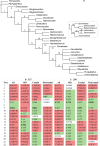Conflict Resolution for Mesozoic Mammals: Reconciling Phylogenetic Incongruence Among Anatomical Regions
- PMID: 32774343
- PMCID: PMC7381353
- DOI: 10.3389/fgene.2020.00651
Conflict Resolution for Mesozoic Mammals: Reconciling Phylogenetic Incongruence Among Anatomical Regions
Abstract
The evolutionary history of Mesozoic mammaliaformes is well studied. Although the backbone of their phylogeny is well resolved, the placement of ecologically specialized groups has remained uncertain. Functional and developmental covariation has long been identified as an important source of phylogenetic error, yet combining incongruent morphological characters altogether is currently a common practice when reconstructing phylogenetic relationships. Ignoring incongruence may inflate the confidence in reconstructing relationships, particularly for the placement of highly derived and ecologically specialized taxa, such as among australosphenidans (particularly, crown monotremes), haramiyidans, and multituberculates. The alternative placement of these highly derived clades can alter the taxonomic constituency and temporal origin of the mammalian crown group. Based on prior hypotheses and correlated homoplasy analyses, we identified cheek teeth and shoulder girdle character complexes as having a high potential to introduce phylogenetic error. We showed that incongruence among mandibulodental, cranial, and postcranial anatomical partitions for the placement of the australosphenidans, haramiyids, and multituberculates could largely be explained by apparently non-phylogenetic covariance from cheek teeth and shoulder girdle characters. Excluding these character complexes brought agreement between anatomical regions and improved the confidence in tree topology. These results emphasize the importance of considering and ameliorating major sources of bias in morphological data, and we anticipate that these will be valuable for confidently integrating morphological and molecular data in phylogenetic and dating analyses.
Keywords: Mesozoic mammals; Multituberculata; australosphenida; correlated homoplasy; haramiyida; incongruence.
Copyright © 2020 Celik and Phillips.
Figures







References
-
- Allin E. F. (1975). Evolution of the mammalian middle ear. J. Morphol. 147 403–438. - PubMed
-
- Archer M., Flannery T., Ritchie A., Molnar R. (1985). First mesozoic mammal from Australia—an early Cretaceous monotreme. Science 318 363–366. 10.1038/318363a0 - DOI
-
- Archer M., Murray P., Hand S., Godthelp H. (1993). “Reconsideration of monotreme relationships based on the skull and dentition of the Miocene Obdurodon dicksoni,” in Mammal Phylogeny, eds Szalay F. S., Novacek M. J., McKenna M. C. (New York, NY: Springer; ), 75–94. 10.1007/978-1-4613-9249-1_7 - DOI
LinkOut - more resources
Full Text Sources

